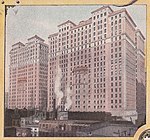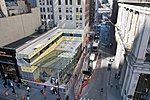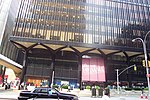3 World Trade Center

3 World Trade Center (also known as 175 Greenwich Street) is a skyscraper constructed as part of the rebuilding of the World Trade Center in Lower Manhattan, New York City. The tower is located on the east side of Greenwich Street, on the eastern side of the World Trade Center site. The current 3 World Trade Center is the second building at the site to bear this name. The original building was the Marriott World Trade Center, a hotel located in the southwest corner of the World Trade Center complex. The hotel was a 22-story steel-framed structure with 825 rooms. It had a roof height of 242 feet (74 m). Construction began in 1979 and it opened in July 1981 as the Vista International Hotel. The entire World Trade Center complex was destroyed during the September 11 attacks in 2001. Construction originally began in 2010, but was delayed until 2014 because of a lack of an anchor tenant. The building's concrete core was topped out to maximum height in August 2016, with the perimeter steel structure following on October 6, 2016. The building opened on June 11, 2018. The building was designed by Rogers Stirk Harbour + Partners, and is managed by Silverstein Properties through a ground lease with the Port Authority of New York and New Jersey, the landowner. It is 1,079 ft (329 m) high, with 80 stories. As of 2021, it is the ninth-tallest building in the city.
Excerpt from the Wikipedia article 3 World Trade Center (License: CC BY-SA 3.0, Authors, Images).3 World Trade Center
Greenwich Street, New York Manhattan
Geographical coordinates (GPS) Address External links Nearby Places Show on map
Geographical coordinates (GPS)
| Latitude | Longitude |
|---|---|
| N 40.710923 ° | E -74.011608 ° |
Address
3 World Trade Center
Greenwich Street 175
10048 New York, Manhattan
New York, United States
Open on Google Maps










